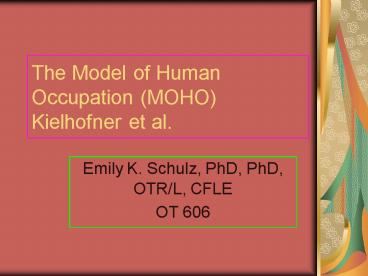The Model of Human Occupation MOHO Kielhofner et al. - PowerPoint PPT Presentation
1 / 16
Title:
The Model of Human Occupation MOHO Kielhofner et al.
Description:
... care of yourself, rest, and sleep (e.g., classroom, kitchen, bedroom, office). (Objects = Tools, supplies, furniture, appliances, clothes, vehicles, and other ... – PowerPoint PPT presentation
Number of Views:5637
Avg rating:3.0/5.0
Title: The Model of Human Occupation MOHO Kielhofner et al.
1
The Model of Human Occupation (MOHO)Kielhofner
et al.
- Emily K. Schulz, PhD, PhD, OTR/L, CFLE
- OT 606
2
MOHO Brief Overview
- MOHO was first published in 1980 as a series of 4
articles. The first edition of the book A Model
of Human Occupation Theory and Application was
published in 1985. - A decade later, the second edition of the text
became available and represented the cumulative
contributions of colleagues from throughout the
world. - The third and most current edition of the text
provides the latest theory and expanded resources
for practice. - While the text is central authoritative resource
on MOHO theory and practice, a large number of
publications and other resources are available to
persons who want to learn more about and use this
model. - http//www.uic.edu/ahp/OT/MOHOC/Intro_to_MOHO/intr
o_to_moho.html
3
MOHO Brief Overview
- The Model of Human Occupation (MOHO) is a
practice model designed to provide theory along
with practical tools and strategies for
occupational therapy and related rehabilitation
practice. - MOHO concepts focus on how people are motivated
toward their occupations (i.e., work, play, and
self care), how they learn and sustain
occupational patterns in life, and how they
engage in physical, cognitive, and social action.
- MOHO also focuses on the importance of the
environment on occupation. MOHO emphasizes that
through therapy persons are helped to engage in
doing things that maintain, restore, reorganize,
or develop their capacities, motives, and
lifestyles. - http//www.uic.edu/ahp/OT/MOHOC/Intro_to_MOHO/intr
o_to_moho.html
4
MOHO Concepts
- MOHO addresses how occupation is motivated,
patterned, and performed. - Humans in this model are conceptualized as being
comprised of three interrelated components
volition, habituation, and performance capacity. - Volition refers to the motivation for occupation,
- Habituation refers to the process by which
occupation is organized into patterns or
routines, and - Performance capacity refers to the physical and
mental abilities that underlie skilled
occupational performance. - http//www.moho.uic.edu/intro
5
MOHO Four Concepts
- Since MOHO emphasizes that to understand human
occupation, we must understand the physical and
social environments in which it takes place, the
model looks at occupation and problems of
occupation that occur in terms of its four
primary concepts of - volition,
- habituation,
- performance capacity and
- environmental context.
6
MOHO (1985)
7
MOHO (1995)
8
MOHO (1997)
9
Figure from Model of Human Occupation, 3rd Ed.
(2002) - illustrating the emergence of values
http//www.uic.edu/ahp/OT/MOHOC/Products/products.
html
10
Figure from Model of Human Occupation, 3rd Ed.
(2002) - illustrating the process of volitional
change over time
http//www.uic.edu/ahp/OT/MOHOC/Products/products.
html
11
Figure from Model of Human Occupation, 3rd Ed.
(2002) - illustrating the content of volitional
thoughts and feelings.
http//www.uic.edu/ahp/OT/MOHOC/Intro_to_MOHO/intr
o_to_moho.html
12
Christy Brown and MOHO My Left Foot
- Analysis
13
My Left Foot Christy Brown and MOHO
My Left Foot Christy Brown and MOHO
14
My Left Foot Christy Brown and MOHO
My Left Foot Christy Brown and MOHO
15
My Left Foot Christy Brown and MOHO
My Left Foot Christy Brown and MOHO
16
Questions and Answers
- ?






























